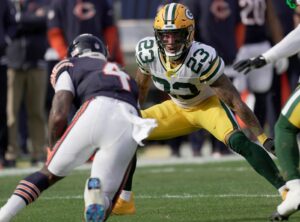Every now and then a player disappoints fantasy football managers, whether it be a game, several games, or a season. Once that happens, most owners are hesitant to forgive said player. Letting go does not seem to be in the vocabulary of most fantasy players. We hold grudges like we’ve divorced said player, split up the assets, and just hope not to run into them at social gatherings.
Sometimes, those players rebound and make right what they did wrong. Sometimes fantasy owners offer forgiveness. Other times, we stay divorced and aren’t willing to give that player a second chance, despite any on-field attempts at reconciliation.
Buffalo Bills second-year wide receiver Zay Jones qualifies for many as one such a player.
It’s Time to Take Zay Jones Serious for Fantasy Football
The Past
One could argue that Jones put up shutdown corner type of numbers his rookie season. He saw targets but managed very little with them. He finished the season catching 27-of-48 passes (36.4 percent) for 316 yards and two touchdowns.
Jones produced at a fantastic rate in college, amassing 1,746 yards on 158 receptions. He followed that up with a strong outing at the NFL Combine. He ranked in or above the 80th percentile in all workout metrics. Per playerprofiler.com he finished in the 88th percentile overall SPARQ score. This led to a second-round selection by the Buffalo Bills.
To be fair, it is expected that rookie wide receivers take some time to adapt to playing in the pros. The speed of the game is one factor and the complexity of the playbook is another. It also takes time to build some chemistry with their quarterbacks. The talent that seemed so evident in college didn’t translate during Jones’ rookie campaign.
The Present
Coming into his second season, Jones was rightfully overlooked in all but the deepest of redraft fantasy leagues. To begin the season there was a revolving door of receivers to contend for targets with. The quarterback situation went from bad, to a little better, to dumpster fire all in a three-game span. In the NFL, not all targets are created equal. Targets from Nathan Peterman are worse than targets from a quarterback like Cam Newton, who’s not known for being highly accurate.
First-round rookie quarterback Josh Allen stepped in pretty quickly and struggled, though less than Peterman did, to move the offense. Allen returned from a multi-week injury and in the two games since has improved at both running this offense and at running in general. While Allen’s game has shifted to the dual-threat mentality, he’s also shown more rapport with his receivers. The biggest beneficiary has been Jones.
The Bills recently parted ways with troubled wide receiver Kelvin Benjamin. This shows not only that they weren’t happy with Benjamin’s on-the-field play, but that they were at a point where they felt they could trust Jones as the alpha for this receiving core.
He has seen at least four targets in all but three games this season. In 12 games this season he has surpassed his previous season’s total receptions and touchdowns and drastically improved his catch rate. In his last game, Jones totaled 67 yards and two scores on nine targets.
The Future
With the departure of Benjamin, Jones’ expected target share should maintain if not improve. Allen is showing early signs of good development but still needs some work for consistent production in the passing aspect of his game. Jones fantasy floor has become more stable in recent weeks. The inconsistencies of this offense as a whole is a major drawback here.
Jones should be viewed as a flex option in 12 teams leagues. He could also fill in for teams who’ve recently dealt with season-ending injuries of Emmanuel Sanders, Marvin Jones Jr., and A.J. Green. While his fantasy ceiling is capped more by his offense overall than his talent, his floor remains consistent. He remains a volume play better suited to PPR leagues.






